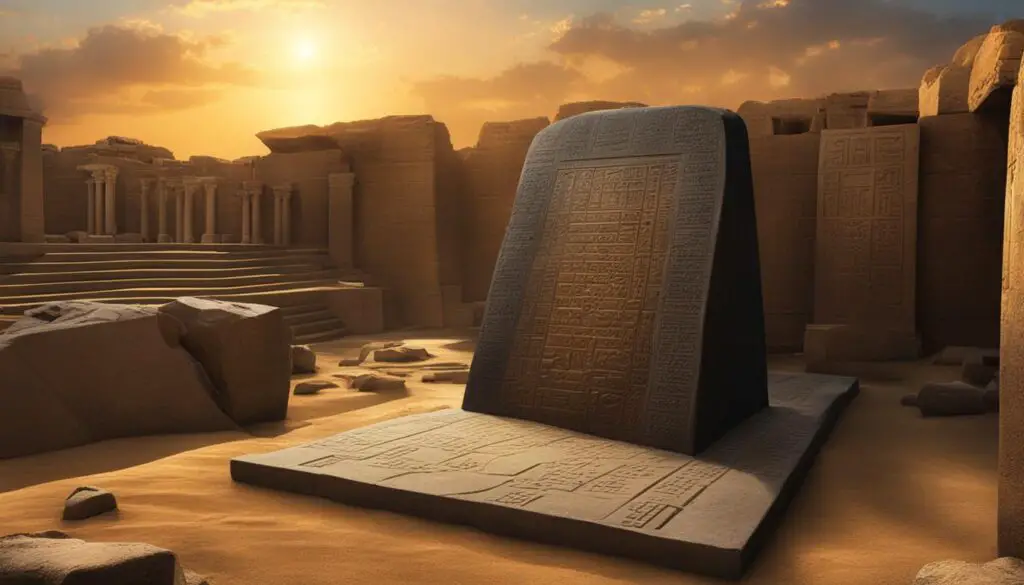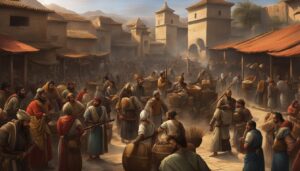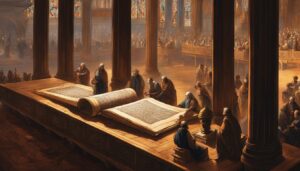
When it comes to understanding the historical accuracy of biblical narratives, archaeological discoveries play a crucial role. The ancient ruins and religious artifacts unearthed by archaeologists provide tangible evidence that sheds light on the events described in the Bible.
In this article, I will discuss some of the most significant archaeological finds that have deepened our understanding of biblical accounts. From ancient texts to monumental structures, these discoveries have provided valuable insights into biblical history and confirmed the authenticity of biblical narratives.
Let’s explore the fascinating world of biblical archaeology and discover how these ancient pieces of evidence support the stories we find in the Bible.
Key Takeaways:
- Archaeological discoveries provide tangible evidence that supports biblical narratives.
- Ancient ruins and religious artifacts offer insights into the events described in the Bible.
- The historical accuracy of the Bible is reinforced by these archaeological findings.
- Biblical archaeology deepens our understanding of biblical history.
- Ancient evidence confirms the authenticity of biblical accounts.
The Rosetta Stone: Decoding Ancient Egypt
The Rosetta Stone, discovered in Egypt in 1799, is a significant archaeological find that has played a pivotal role in decoding ancient Egyptian hieroglyphics and advancing the field of Egyptology studies. This large slab of black granite bears inscriptions in three scripts: Greek, Demotic, and hieroglyphics.
With the discovery of the Rosetta Stone, scholars were able to decipher ancient Egyptian hieroglyphics for the first time in centuries. The ability to understand this ancient script provided valuable insights into Egyptian culture, religion, and history.
The Rosetta Stone has been instrumental in shedding light on the historical accuracy of the Bible, particularly in relation to events that took place in Egypt. By studying the cultural context of biblical accounts that occurred in Egypt, researchers have gained a deeper understanding of the biblical narratives.
Furthermore, the deciphering of hieroglyphics opened up new avenues for Egyptology studies. By analyzing ancient Egyptian texts, scholars have been able to gain a broader perspective on the civilization’s achievements, beliefs, and societal structures.

The Impact of the Rosetta Stone
The discovery and deciphering of the Rosetta Stone have had a profound impact on both the study of ancient Egypt and our understanding of biblical accounts set in Egypt. It stands as a testament to the rich historical and cultural heritage of this ancient civilization.
| Advancements in the Field of Egyptology | Insights into Biblical Narratives |
|---|---|
| Decoding hieroglyphics | Understanding the cultural context of biblical events in Egypt |
| Deeper understanding of Egyptian culture and religion | Confirmation of the historical accuracy of the Bible |
| Unveiling of ancient Egyptian achievements and societal structures | Exploration of the influence of Egyptian culture on biblical stories |
The Dead Sea Scrolls: Unlocking Ancient Texts
The discovery of the Dead Sea Scrolls in caves near the Dead Sea in 1947 was an extraordinary find that has had a profound impact on our understanding of ancient texts. These scrolls, a collection of ancient manuscripts, contain copies of nearly all the books of the Hebrew Bible, also known as the Old Testament.
Dating back to 150 BCE – 70 CE, the Dead Sea Scrolls provide the earliest known copies of Old Testament books. Their importance lies in their ability to shed light on the textual reliability of the Bible. When compared with later Hebrew texts, the variations in the biblical text itself are minimal, confirming the remarkable accuracy of the transmission of the biblical text throughout the centuries.
Moreover, the Dead Sea Scrolls have not only contributed to our understanding of the historical accuracy of the Bible but have also provided valuable insights into the ancient Israelite religion. These manuscripts reveal different interpretations and understandings of Israelite religious practices, giving us a glimpse into the diverse religious landscape of the time.
In short, the discovery of the Dead Sea Scrolls has been instrumental in unlocking ancient texts and deepening our knowledge of the Hebrew Bible, as well as enhancing our understanding of the historical context and cultural milieu in which biblical texts were written.
FAQ
What is the significance of the Rosetta Stone?
The Rosetta Stone, discovered in Egypt in 1799, provided the key to deciphering ancient Egyptian hieroglyphics and opened up the field of Egyptology studies. It has contributed to our understanding of biblical accounts that took place in Egypt.
What are the Dead Sea Scrolls?
The Dead Sea Scrolls, found in 1947 in caves near the Dead Sea, are a collection of ancient manuscripts that include copies of nearly all the books of the Hebrew Bible. They offer valuable insights into the transmission of the biblical text and have enhanced our understanding of the historical accuracy of the Bible.
What is the Tel Dan Inscription?
The Tel Dan Inscription, discovered in 1993, contains the phrase “house of David” and provides evidence for the existence of King David. It contributes to our understanding of biblical history and archaeological support for biblical narratives.
What are the Ketef Hinnom Scrolls?
The Ketef Hinnom Scrolls, found in 1979, are the earliest known citations of biblical texts in Hebrew and confirm the early date of the priestly benediction from Numbers 6. They provide evidence for the historical accuracy of the Bible and the cultural context of biblical events.
What does the Moabite Stone reveal?
The Moabite Stone, discovered in 1868, contains a text dating to the ninth century BC that describes a war between Moab and Israel, paralleling the biblical account in 2 Kings 3. It highlights the historical accuracy of the Bible and the influence of ancient Mesopotamian literature on biblical stories.
What is Hezekiah’s Tunnel?
Hezekiah’s Tunnel, built in the eighth century BC to provide water to Jerusalem, is mentioned in the Bible and provides evidence for the historical accuracy of the biblical account. It contributes to our understanding of ancient ruins and Bible stories.
What is the Epic of Gilgamesh?
The Epic of Gilgamesh, discovered in 1872, shares similarities with the biblical narrative of Noah’s flood and highlights the influence of ancient Mesopotamian literature on biblical stories. It offers insights into biblical events and the cultural context of the time.
Source Links
- https://www.crossway.org/articles/10-crucial-archaeological-discoveries-related-to-the-bible/
- https://www.biblicalarchaeology.org/free-ebooks/ten-top-biblical-archaeology-discoveries/
- https://christianpublishinghouse.co/2023/07/17/top-ten-discoveries-in-biblical-archaeology-relating-to-the-old-testament/








